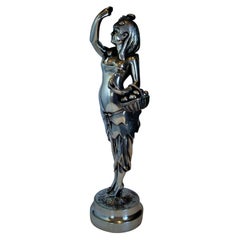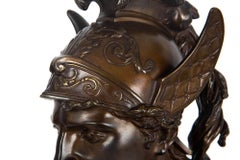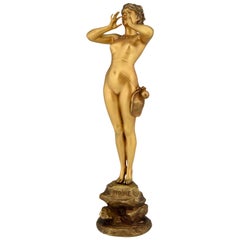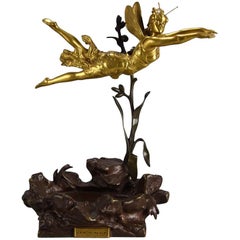Alfred Grevin
to
1
1
1
1
1
1
1
1
1
1
1
27
11,709
3,899
2,413
2,232
Creator: Alfred Grevin
19th Century Art Nouveau Bronze Sculpture of a Female Hen by A. Grevin & F. Beer
By Alfred Grevin
Located in Buenos Aires, Olivos
19th century Art Nouveau silvered bronze sculpture of female hen by A. Grevin & F. Beer.
Women Dressed as a Hen, she has a basket of eggs. On circular base incised " A. Grevin et Be...
Category
Late 19th Century French Art Nouveau Antique Alfred Grevin
Materials
Bronze
$1,999 Sale Price
28% Off
Related Items
French Bronze Sculpture 19th century
Located in Shippensburg, PA
Measurements: 18 1/8" H x 8 1/4" W x 5 1/4" D
Condition Report:
Natural age related variation to the patina including surface staining, light wear, trace tarnish and underlying accr...
Category
19th Century French Romantic Antique Alfred Grevin
Materials
Bronze
19th Century French Bronze Sculpture
Located in Atlanta, GA
This exquisite 19th-century French bronze sculpture captures the essence of rural life through the figure of a young peasant boy. The boy is depicted with a charming, rustic appeal,...
Category
19th Century Italian Antique Alfred Grevin
Materials
Metal, Bronze
19th Century Bronze Venus Sculpture
Located in Charlottesville, VA
A reclining bronze of Venus. There is great detail in the casting.
Category
19th Century French Antique Alfred Grevin
Materials
Bronze
19th Century Classical Bronze Draped Female Sculpture, Signed Delafortaine
By AUGUST MAXIMILIEN DELAFONTAINE
Located in Lambertville, NJ
Patinated cast bronze classical female bronze figure of a draped woman, signed Delafontaine. The Delafontaine bronze factory was first established ...
Category
19th Century Neoclassical Revival Antique Alfred Grevin
Materials
Bronze
$3,750
H 26 in W 7.5 in D 6.75 in
19th Century Art Nouveau Bronze Bust Entitled "Bohémienne" by Emmanuel Villanis
By Emmanuel Villanis
Located in London, GB
Captivating late 19th century French bronze bust of a beautiful woman, enhanced by the variegated rich brown patination and excellent tactile surface detail, raised on an integral bronze base with raised title to the fore. Signed ?E Villanis and further raised on a breche griotte stepped and shaped marble plinth
ADDITIONAL INFORMATION
Height: 33 cm
Width: 16 cm
Depth: 11 cm
Condition: Excellent Original Condition
circa: 1890
Materials: Bronze
Book Ref: Emmanuel Villanis by Josje Hortulanus-de Mik
Page No: 17
SKU: 8616
ABOUT
Puccini's Opera - La Bohème
SYNOPSIS - A group of friends are living a Bohemian life in Paris and trying to make their livings creating art. Rodolfo, the writer, falls in love with the seamstress, Mimi, while Marcello, the painter, and Musetta, the singer, are the on-and-off-again couple by their sides. When the four are happy, they spend their time celebrating life and love. However, Mimi is revealed to be very ill, and Rodolfo struggles to come to terms with the fact that she will inevitably die. Rodolfo and Mimi break up, and months later, Musetta discovers Mimi extremely sick and close to death. She brings Mimi to Rodolfo and Marcello's apartment. Rodolfo immediately takes her in and tries to nurse her back to health, but he is too late. Almost as soon as the two are reunited and have professed their love for one another, Mimi succumbs to her illness and dies.
Emmanuel Villanis
Emmanuel Villanis was an industrious man. He is believed to have created some 200 to 250 pieces. His oeuvre pre-eminently consisted of busts and full body statues. Most of these were manufactured in bronze, but there are also models in white metal and terra cotta. Different patinas were used. The bronzes were mainly cast by the Societé de Bronzes de Paris and can be recognised by the round stamp...
Category
Late 19th Century French Art Nouveau Antique Alfred Grevin
Materials
Marble, Bronze
$4,764
H 13 in W 6.3 in D 4.34 in
French 19th-20th Century Art-Nouveau Bronze Patinated Bust of Marie Antoinette
By Agathon Léonard
Located in Los Angeles, CA
A fine French 19th-20th century Art-Nouveau patinated bronze bust of "Marie Antoinette" (Queen of France 1755-1793), after the model by Agathon Léonard or Léonard Agathon van Weydeve...
Category
Early 1900s French Art Nouveau Antique Alfred Grevin
Materials
Bronze
$12,450 Sale Price
34% Off
H 31 in W 21.25 in D 13.75 in
Late 19th Century Art Nouveau Bronze figure "Slave Girl" by Emmanuel Villanis
By Emmanuel Villanis
Located in London, GB
A beautiful patinated Art Nouveau bronze study of a young Art Nouveau beauty sat upon a wall wearing chains with excellent variegated rich brown patina and excellent hand chased surf...
Category
Late 19th Century French Art Nouveau Antique Alfred Grevin
Materials
Bronze
$3,813
H 9.85 in W 7.09 in D 4.73 in
19th Century Bronze Sculpture of a Lady by Moreau
By Hippolyte François Moreau
Located in London, GB
This alluring bronze depicts the full-length figure of a young lady who, swathed in draped clothing, looks downward toward a basket of flowers hung about her waist. The circular base...
Category
Late 19th Century French Belle Époque Antique Alfred Grevin
Materials
Bronze
Late 19th Century Bronze Sculpture of a Female Warrior by E. Drouot
By Edouard Drouot
Located in Long Island City, NY
Late 19th century bronze sculpture of a female warrior with sword
Signed E Drouot
Edouard Drouot was born in Sommevoire in the Haut Marne region on 3rd ...
Category
Late 19th Century French Belle Époque Antique Alfred Grevin
Materials
Bronze
Late 19th Century Art Nouveau Sculpture "Girl in Cloak" by Vernon March
Located in London, GB
An excellent late 19th Century patinated Art Nouveau bronze study of a naked beauty standing on a podium with a cape draped over her shoulders, raised on a marble plinth and signed
...
Category
Late 19th Century English Art Nouveau Antique Alfred Grevin
Materials
Bronze
Late 19th Century Art Nouveau Sculpture "Nature Unveiling" by Ernst Barrias
Located in London, GB
Wonderful late 19th Century Art Nouveau French bronze figure of a seductively draped female figure representing, in allegorical form, Nature revealing her secrets to Science, a fitti...
Category
Late 19th Century French Art Nouveau Antique Alfred Grevin
Materials
Marble, Bronze
$10,101
H 10.63 in W 4.34 in D 3.15 in
Late 19th Century Art Nouveau Bronze "Nouveau Lady" by Georges Van Der Straeten
By Georges Van der Straeten
Located in London, GB
A delightful Art Nouveau Bronze figure of a young beauty scantily dressed with only a shawl draped across her body in a striking pose. The surface of the bronze with rich golden/brow...
Category
Late 19th Century Belgian Art Nouveau Antique Alfred Grevin
Materials
Bronze
$3,154
H 15.36 in W 11.82 in D 8.27 in
Previously Available Items
Art Nouveau Bronze Sculpture Calling Nude Lady Alfred Grevin and Friedrich Beer
By Alfred Grevin
Located in Antwerp, BE
Art Nouveau bronze sculpture standing nude lady calling.
Title: “Ho, he” or Calling girl.
Signed by Alfred Grevin 1827-1892 and Friedrich Beer.
France, circa 1880.
The same sc...
Category
Late 19th Century French Art Nouveau Antique Alfred Grevin
Materials
Bronze
H 19.69 in W 6.5 in D 4.93 in
Art Nouveau Bronze “La Mouche d'Or” by Alfred Grévin
By Alfred Grevin
Located in London, GB
A fabulous late 19th century French Art Nouveau bronze vide pouche of an elegant beauty in the form of a winged nymph ‘The Golden Fly’ hovering over a pool of water. The sculpture wi...
Category
Late 19th Century French Art Nouveau Antique Alfred Grevin
Materials
Bronze
19th Century Art Nouveau Bronze Sculpture of a Female Adventurer by A. Grevin
By Alfred Grevin
Located in San Francisco, CA
19th century Art Nouveau bronze sculpture of a female adventurer titled "Ho!He", circa 1880. Signed Grevin/Beer. E.Tassel foundry.
A robust nude car...
Category
Late 19th Century French Art Nouveau Antique Alfred Grevin
Materials
Bronze
H 20.5 in W 6.5 in D 5.75 in
Alfred Grevin furniture for sale on 1stDibs.
Alfred Grevin furniture are available for sale on 1stDibs. These distinctive items are frequently made of metal and are designed with extraordinary care. There are many options to choose from in our collection of Alfred Grevin furniture, although gold editions of this piece are particularly popular. Many of the original furniture by Alfred Grevin were created in the Art Nouveau style in france during the 19th century. If you’re looking for additional options, many customers also consider furniture by Jerome Massier, Jean Garnier, and Isidore Jules Bonheur. Prices for Alfred Grevin furniture can differ depending upon size, time period and other attributes — on 1stDibs, these items begin at $2,000 and can go as high as $2,000, while a piece like these, on average, fetch $2,000.




